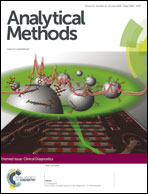A biosensor for the determination of high density lipoprotein cholesterol employing combined surfactant-derived selectivity and sensitivity enhancements
Abstract
High density lipoprotein cholesterol (HDL-C) is a modifiable risk factor in cardiovascular disease and devices suitable for its determination at the point of care are critical to the future management of hypercholesterolaemia. An electrochemical biosensor for measuring HDL-C was developed. The biosensor was based on a homogeneous assay methodology for selective determination of HDL-C in combination with a printed electrochemical sensor for measuring the reduction of hydrogen peroxide at a silver paste electrode. The polyoxyethylene alkylene tribenzylphenyl ether surfactant (Emulgen B-66) was found to be capable of both the selective dissolution of HDL particles, as well as the enhanced electrocatalytic reduction of hydrogen peroxide. The resulting biosensor was shown to have a linear response to HDL-C from 0.5 to 4 mM (r2 = 0.998) with an average r.s.d. of 7%. The biosensor was also used to analyse HDL-C in thirteen serum samples and had good agreement with a commercial spectrophotometric precipitation-based assay (r = 0.72; p < 0.058).

- This article is part of the themed collection: Clinical Diagnostics

 Please wait while we load your content...
Please wait while we load your content...